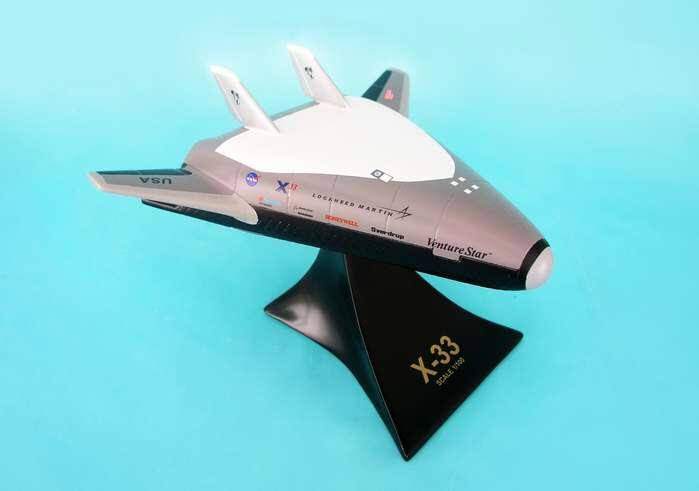NASA - X-33 Venture Star - 1/50 Scale Desktop Resin Model |
|
|
| Lockheed Martin - X-33 Venture Star With the cost of space flight still hovering at around $10,000 per pound, NASA spearheaded the development of a number of potentially revolutionary technology demonstration projects intended to reduce the cost of lifting a pound into orbit to about $1,000. The most significant project under the umbrella of the Space Launch Initiative (SLI) was the Lockheed Martin X-33 announced in 1996. The ultimate goal of the X-33 was to develop a completely reusable single-stage-to-orbit (SSTO) launch vehicle to replace the aging Space Shuttle by about 2010. Although both McDonnell Douglas and Rockwell competed for the X-33, Lockheed's lifting-body wedge shape incorporating a number of advanced features was judged the most promising. Among the critical new technologies Lockheed hoped to develop to make SSTO possible were very strong and lightweight composite fuel tanks, an integrated thermal protection system rather than the heat-absorbing tiles used on the Space Shuttle, automated flight control systems, and linear aerospike engines believed to be more efficient than standard rocket engines. Most importantly, the X-33 needed to demonstrate levels of serviceability, rapid turn-around time between flights, and low-cost maintenance as yet unseen in launch vehicles. If the X-33 technology demonstrator proved successful, NASA and Lockheed Martin hoped to develop a full-sized vehicle twice the size of the X-33 called the VentureStar that would supersede the Space Shuttle as America's primary launch platform. The ambitious project set in motion a rapid test program with the first flight set for early 1999. Unfortunately, these goals proved too ambitious for the X-33 was beset by a number of difficult and time-consuming technical problems. Early wind tunnel and flight tests of X-33 models showed the wedge shape to be longitudinally unstable requiring changes to the control surfaces. In addition, the aerospike engine suffered development delays, as did the thermal protection system. Most critical, however, was the failure of the composite fuel tanks that eventually forced Lockheed Martin to abandon them altogether. Aluminum tanks were instead substituted, but the change forced modifications to the vehicle structure and increased overall weight. Individually, each of these difficulties was probably not fatal, but together they convinced NASA that the X-33 relied on too many untried and unproven technologies that could not be developed for as low a cost and with as great a reliability as the X-33 performance requirements demanded. As a result, NASA cancelled further spending on the X-33 in March 2001 after the vehicle was about 75% complete. Although the decision left Lockheed, who had already invested over $200 million of company funds in the project, free to complete and fly the X-33 alone, the company has elected not to do so and the VentureStar program appears to have been shelved. However, Congressional supporters of the X-33 have been pushing for a renewal of the project as a US Air Force program. |

